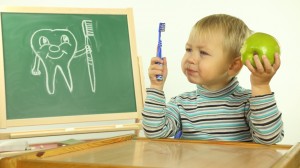 Long before that first teeny-weeny tooth appears, it’s important to take care of your baby’s mouth and gums. Doing so isn’t hard, but it does take a delicate touch. After all, growing teeth can be a bit of an uncomfortable process for your baby, and you want to make the experience as comfortable as possible. Below, we’ve listed out exactly how to take care of that little mouth before and after teeth emerge, and how you can help your child adapt to an oral care routine from an early age.
Long before that first teeny-weeny tooth appears, it’s important to take care of your baby’s mouth and gums. Doing so isn’t hard, but it does take a delicate touch. After all, growing teeth can be a bit of an uncomfortable process for your baby, and you want to make the experience as comfortable as possible. Below, we’ve listed out exactly how to take care of that little mouth before and after teeth emerge, and how you can help your child adapt to an oral care routine from an early age.
Before The First Teeth
Keeping your baby’s gums clean and healthy is essential to making sure strong, healthy teeth emerge later on. Simply moisten a soft washcloth or piece of gauze with warm water and wrap it around your finger. Then, gently rub the cloth along your baby’s gums. Try to do this at least twice a day, particularly after feedings. Not only will this help keep this tiny mouth healthy and free of bacteria, it’ll also get your child used to the feeling of having his or her mouth cleaned, making the transition to a toothbrush a bit easier.
Teething
As your baby’s teeth begin to emerge, you may notice that your baby is fussier than usual, chews objects more frequently, and the gums may appear to be sore. This is normal and shouldn’t cause any concern. To help soothe the discomfort of teething, you can try rubbing your baby’s gums with a cold wash cloth, or put a teething toy in the refrigerator to cool it down. The rubbing motion may help alleviate the pain, and cold can cause a mild numbing effect. If it seems like your child is in a lot of discomfort, consult your pediatrician and pediatric dentist to see if an over-the-counter pain reliever would be appropriate.
The First Teeth
The first teeth — usually the lower incisors — should begin to emerge when your baby is about six months old. Once this happens, you can begin to brush all sides of the teeth and gums using a small, soft toothbrush and a tiny amount of fluoride-free toothpaste (about the size of a grain of rice). Because you’re using such a minuscule amount of toothpaste, your baby won’t need to rinse. Brush the teeth and gums twice a day, especially just before bed.
By the time your child is about three years old, you can switch to a fluoride toothpaste and use about a pea-sized amount. Your child will likely not have the dexterity to brush by themselves until they’re about six, but allowing your child to hold onto the toothbrush while you direct it can help them get the hang of it more quickly.
Getting your baby used to the feeling of having his or her mouth and teeth cleaned is essential to helping your child adopt good oral hygiene habits as they get older. By incorporating soothing motions of rubbing the gums and using soft tools, cleaning your baby’s mouth can be an enjoyable part of the day for both parties. It’s also important to schedule an appointment with a dentist as soon as that first tooth emerges, to make sure everything is growing in as it should. Which reminds us, is it time for your next appointment?







Leave a Reply